LE PAYSAGE IMAGINAIRE
Exhibition: December 6, 2022 – January 8, 2023
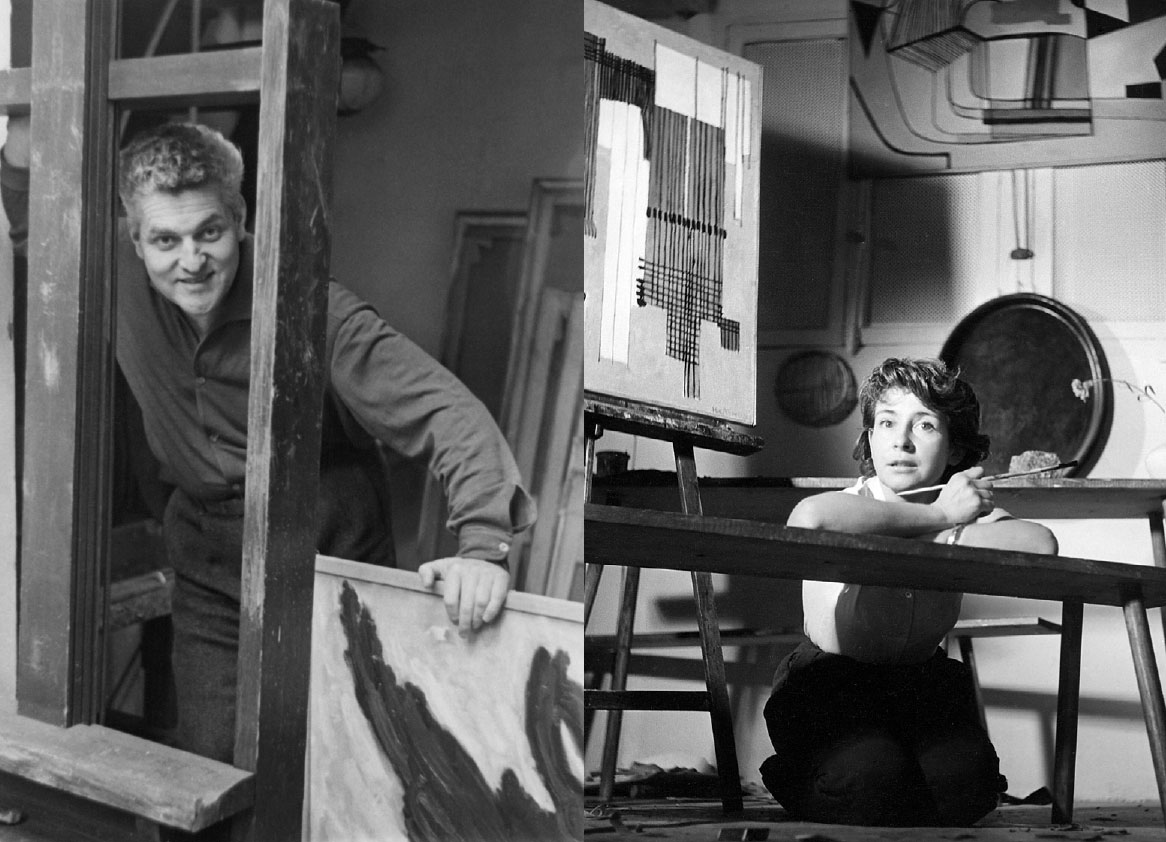
Robert Helman in his studio, 255 boulevard Raspail, Paris, c.1952
Huguette Arthur Bertrand in her studio, boulevard de la Tour-Maubourg, Paris, c.1954
THE IMAGINARY LANDSCAPE
A dialogue between the works of two abstract artists
Huguette Arthur Bertrand (1920-2005) & Robert Helman (1910-1990)
Huguette Arthur Bertrand and Robert Helman’s respective artistic careers unfolded primarily in Paris. Arthur Bertrand moved to Paris in 1946, while Helman arrived in the city in 1927, before going into exile in Barcelona between 1939 and 1945. On his return to France after the Liberation, Helman settled in the City of Light for good. The two artists’ paths would cross in the French capital, where they took part in the same salons: the Salon de Mai, the Salon d’Automne, and the Salon des Réalités Nouvelles, among others. They also had common friends such as Jean Michel Atlan, who had an important influence on both painters, as well as Josef Síma and Pierre Dmitrienko.
A profound interest in nature shared by Huguette Arthur Bertrand and Robert Helman enables us to establish a connection between the two painters. Both artists found their inspiration in the organic world. They did not, however, paint en plein air. Neither artist set up their easels out of doors to create descriptive paintings. Instead, they both chose the seclusion of the studio to explore abstraction – the essence of creation, which would link nature and the inner self on canvas.
Fundamental to many abstract painters, inspiration from nature has given rise to various terms to try to classify and group them together, such as “abstract expressionism” and “abstract landscape painting”. Constructed from a memory or an emotion, this imaginary landscape no longer has any figurative reference points. It is a fusion of lyricism and nature.
In both artists’ works, the movement of the brush is a respiration, a breath. The style of gesture is vital. The palette is naturalist, limited to subtle, telluric shades, in which black plays an integral role. The painters are part of a universal geography, their creations featuring echoing titles such as Comarave and Germination, Abélie (“Abelia”) and Végétation (“Vegetation”), Oiseau (“Bird”) and Migration.
Posed face to face, the paintings of Huguette Arthur Bertrand and Robert Helman invite the viewer on a sensitive, poetic journey punctuated by visual associations between the works. These organic paintings are true imaginary landscapes.
EXHIBITED ARTWORKS
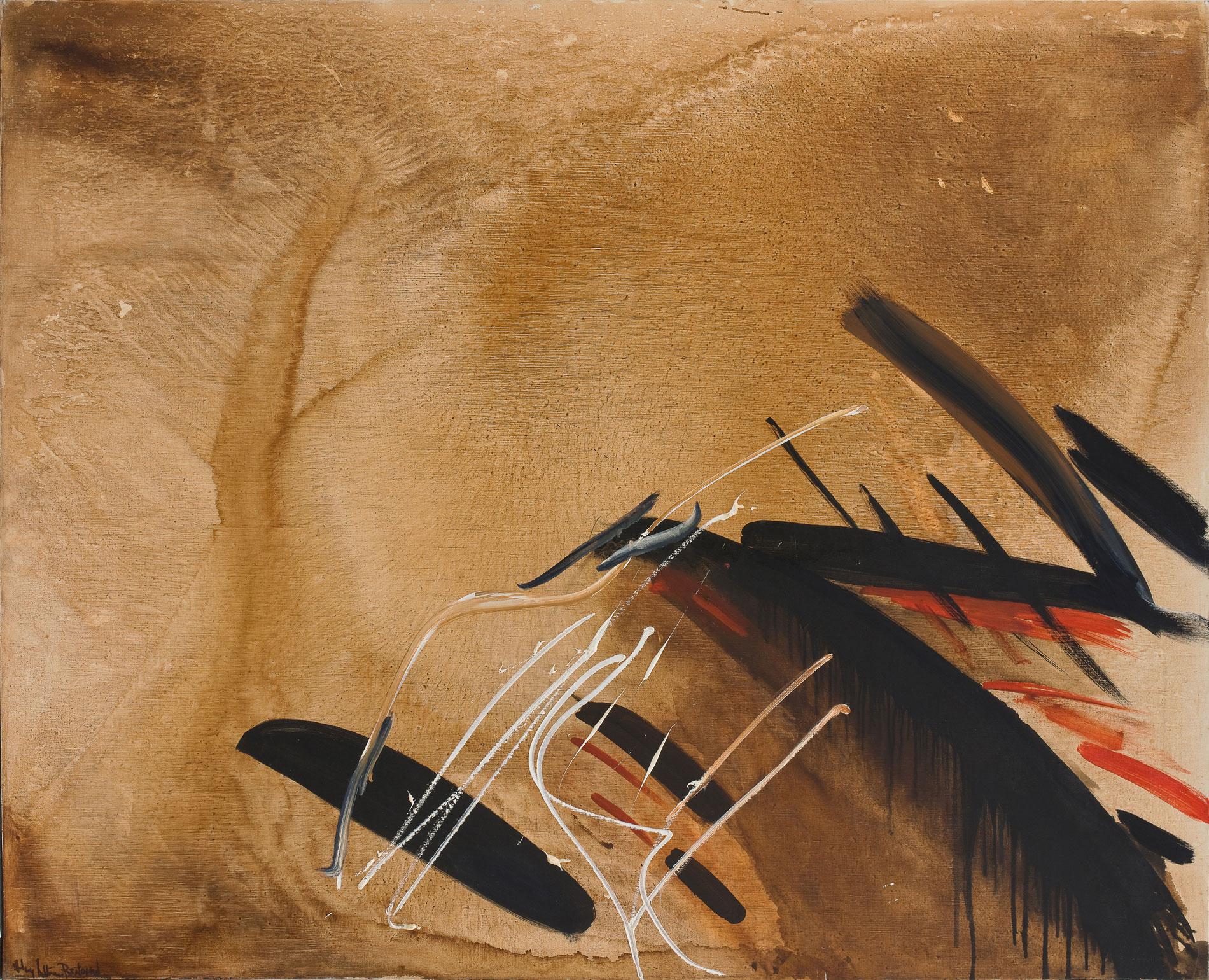
HUGUETTE ARTHUR BERTRAND
Remous, 1984-1986
Oil on canvas
130 x 162 cm – 52 x 64.5 in.
Signed “Hug Arthur Bertrand“ lower left
Signed, dated and titled “Hug Arthur Bertrand 1984-1985-86 remous“ on reverse

ROBERT HELMAN
Germination, c. 1955
Oil on canvas
76 x 95 cm – 29.9 x 37.4 in.
Signed “HELMAN“ upper right

HUGUETTE ARTHUR BERTRAND
Pampelune, c. 1962
Oil on canvas
81 x 100 cm – 31.9 x 39.4 in.
Titled “Pampelune” on reverse
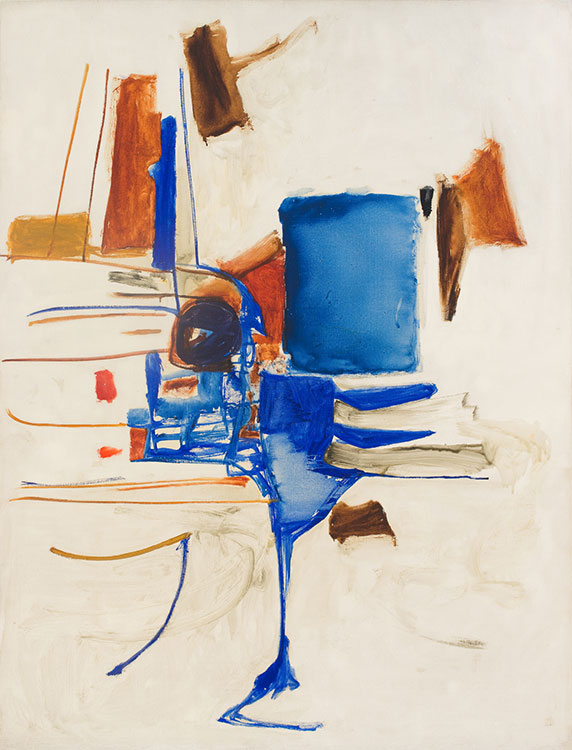
HUGUETTE ARTHUR BERTRAND
Abélie, 1962-1963
Oil on canvas
116 x 89 cm – 45.7 x 35 in.
Titled “ABELIE” on reverse

ROBERT HELMAN
Germination, 1971
Oil on canvas
99 x 132 cm – 38.9 x 52 in.
Signed “HELMAN“ lower right

HUGUETTE ARTHUR BERTRAND
Migration, 1965
Oil on canvas
61 x 61 cm – 24 x 24 in.
Signed “Hug Arthur Bertrand” lower left
Signed, titled and dated “Huguette Arthur Bertrand Migration 65” on reverse
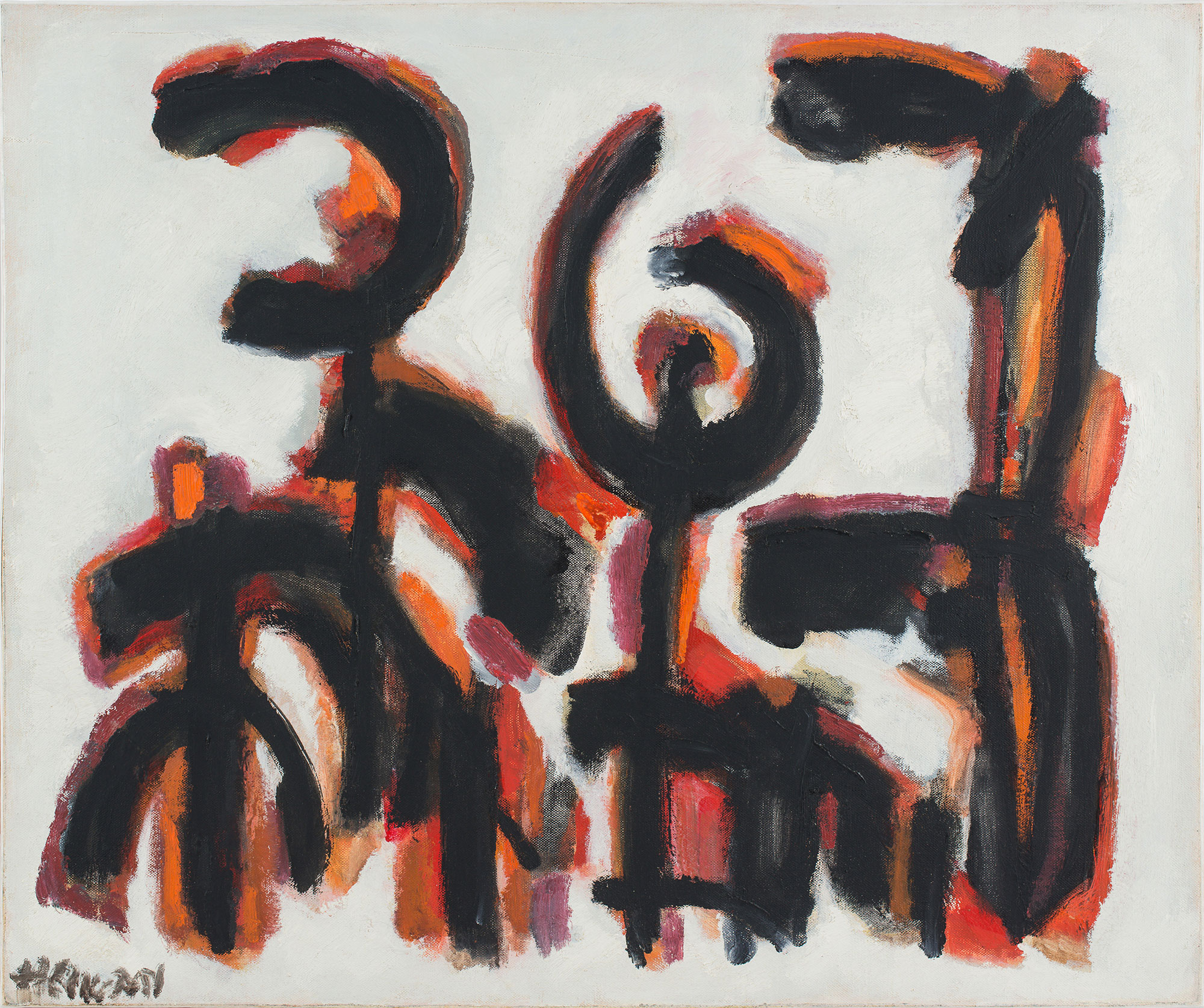
ROBERT HELMAN
Germination, c. 1969
Oil on canvas
21.5 x 25.8 in.
Signed “HELMAN“ lower left
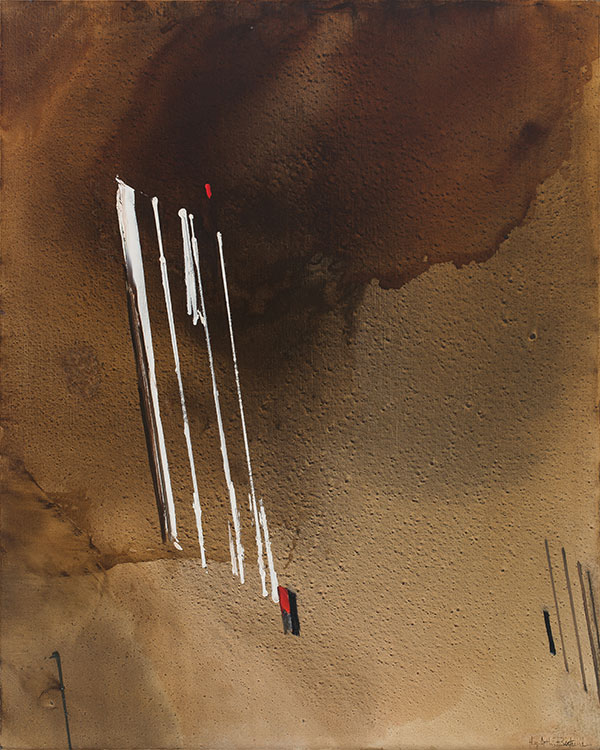
HUGUETTE ARTHUR BERTRAND
Voie directe, 1992
Oil on canvas
162 x 130 cm – 64.5 x 52 in.
Signed “Hug. Arthur Bertrand“ lower right
Signed, titled and dated on reverse
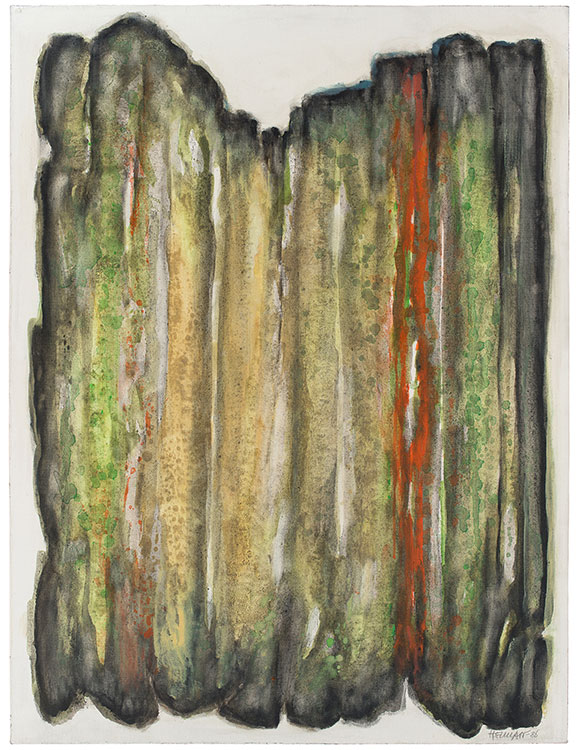
ROBERT HELMAN
Genèse, 1986
Acrylic on canvas
116 x 89 cm – 45.7 x 35 in.
Signed and dated “HELMAN – 86“ lower right
Signed and dated “HELMAN 1986“ on reverse
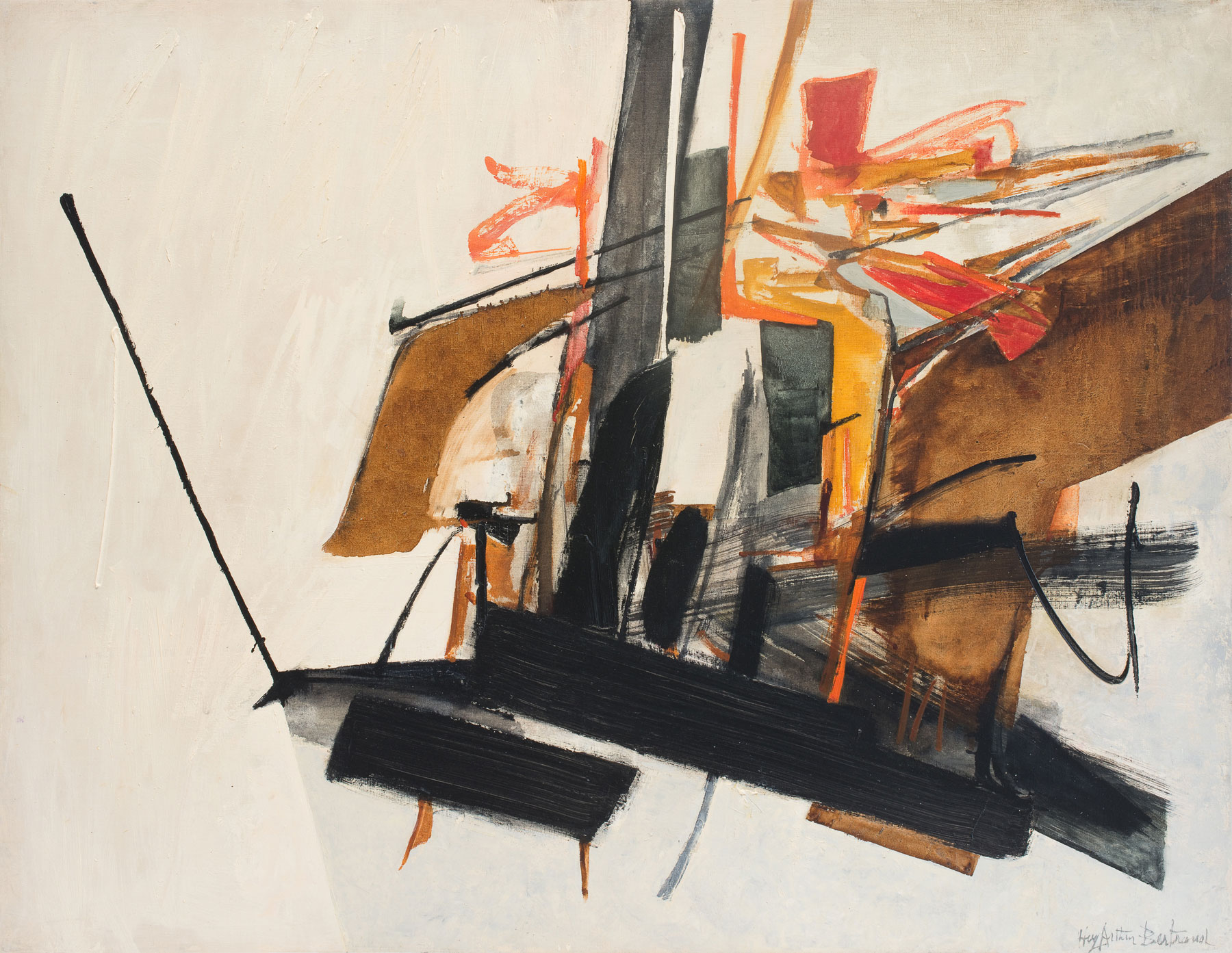
HUGUETTE ARTHUR BERTRAND
Comarave, 1961
Oil on canvas
89 x 116 cm – 35 x 45.7 in.
Signed “Hug Arthur Bertrand” lower right
Dated and titled “mai-juin 1961 comarave” on reverse

ROBERT HELMAN
Germination, 1969
Oil on canvas
96 x 123,5 cm – 37.8 x 48.6 in.
Signed and dated “HELMAN 69“ lower right
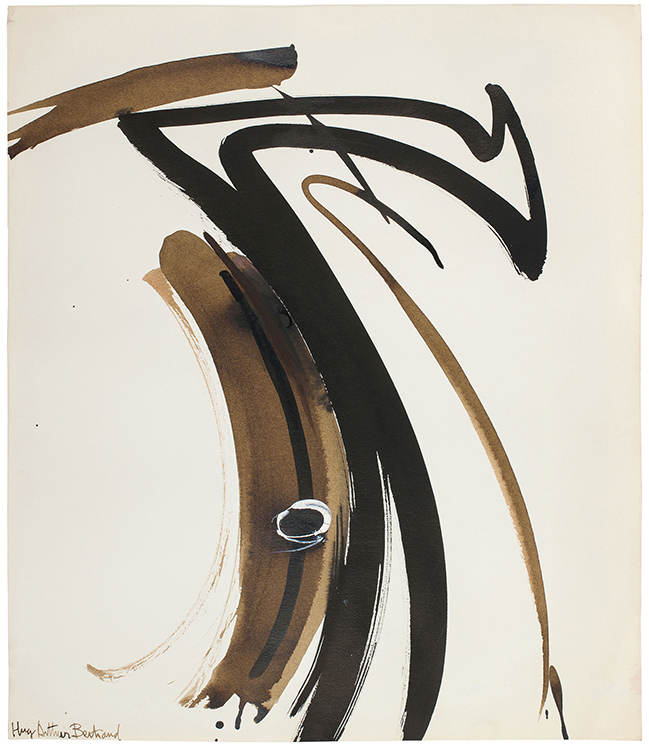
HUGUETTE ARTHUR BERTRAND
Œil, c. 1990
Ink and gouache on paper
38 x 33 cm – 15 x 13 in.
Signed “Hug Arthur Bertrand” lower left
Titled and signed “- oeil – H.A. Bertrand” on reverse
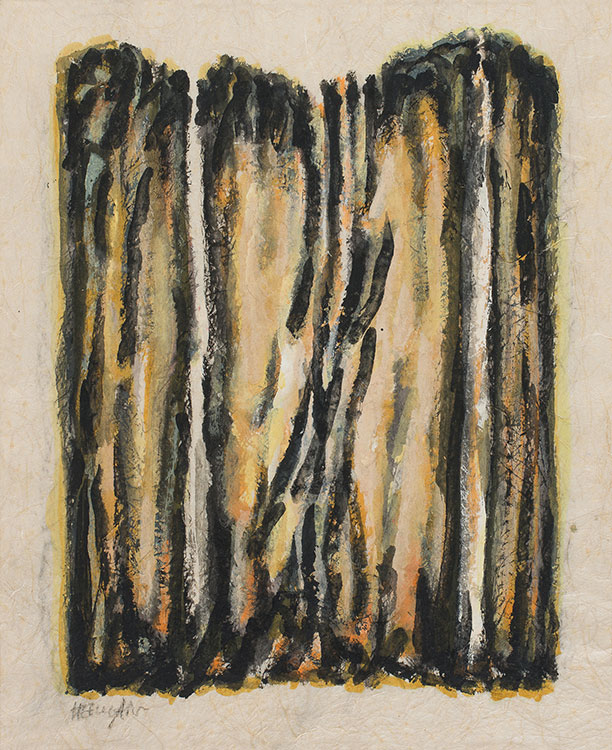
ROBERT HELMAN
Genèse, c. 1983
Gouache on Japanese paper
52 x 42,5 cm – 20.5 x 16.7 in.
Signed “HELMAN 69“ lower left
Huguette Arthur Bertrand (1920-2005)
Biography
A YOUNG WOMAN PAINTER IN POST-WAR PARIS
Born in 1920 in Écouen, Huguette Arthur Bertrand spent her childhood in Roanne (center south of France) and settled in Paris shortly after the war. She attended the Académie libre de la Grande Chaumière. A fellowship allowed her to spend a year in Prague between 1946 and 1947 where she had her first solo exhibition. She met the painter Joseph Síma there.
A rare painter woman in the essentially masculine artistic landscape of Postwar Paris, she immersed herself fully in the buzzing art world of Montparnasse and Saint-Germain-des-Prés. Huguette Arthur Bertrand became friendly with publishers, critics (Michel Ragon) and abstract artists, those of the Galerie Denise René: Jean Dewasne, Jean Deyrolle, Serge Poliakoff; and with Martin Barré, Pierre Dmitrienko, James Guitet, Kumi Sugaï and John F. Koenig. On Saturdays she would visit Jean-Michel Atlan’s studio with Marcelle Loubchansky. She participated with passion in this artistic effervescence, marked by lively debate between figurative and abstract art, but also between supporters of “cold” abstraction and those of “warm” abstraction: one geometric, the other gestural, lyrical, guided by a free and spontaneous gesture.
IN THE 1950’S, HUGUETTE ARTHUR BERTRAND’S SUCCESS IN PARIS
During the 1950s, Huguette Arthur Bertrand applied the full force of her art and the confidence of her artistic vocabulary made from stripes that hatch, streak, give rhythm to compositions. A powerful way of painting that confuses. A solid form of painting that marks a determined, independent character, “a type of painting that does not appear feminine at all; even muscular painting, strong, dynamic in a way that would appear masculine […]” as Michel Ragon wrote. The woman artist Huguette Arthur Bertrand’s explosive work, which was definitively abstract from 1950, presents an audacious palette, full of colour that gradually evolved towards more dramatic shades, concentrated in a range of ochre, brown, orange-red.
In 1949 and 1950, Huguette Arthur Bertrand participated in the key exhibition Les Mains Éblouies (The Dazzled Hands) at the Galerie Maeght alongside Pierre Dmitrienko, and with Cobra artists in 1950 (Pierre Alechinsky, Corneille, Jacques Doucet). In Paris, from the start of the 1950s, several galleries exhibited the painter woman’s work: Galerie Niepce, Galerie La Roue, Galerie Arnaud above all…
Huguette Arthur Bertrand regularly participated in the main salons of abstract art in Paris, at the Salon de Mai from 1949 until the late 1980s, at the Salon des Réalités Nouvelles until the 1990s, and at the Salon d’Automne. The year 1955 was decisive for her: she won the famous Prix Fénéon (Fénéon award). In 1956, Huguette Arthur Bertrand participated in the Festival de l’Art d’Avant-Garde, a major event held at Le Corbusier’s Cité Radieuse in Marseille.
HUGUETTE ARTHUR BERTRAND’S INTERNATIONAL RECOGNITION
Her works began to travel abroad: a solo exhibition was held at the Brussels Palais des Beaux-Arts in 1956, and crossed the Atlantic: in 1956, the Meltzer Gallery in New York organized for the woman artist a solo exhibition in 1956, praised by critics, then a group show the year after: North and South Americans and Europeans. Also in 1957, the painter Huguette Arthur Bertrand participated in the exhibition New Talents in Europe at the University of Alabama. In 1958 and in 1960-61, she exhibited at the Howard Wise Gallery in Cleveland.
The works of the painter woman Huguette Arthur Bertrand continued to be exhibited in many different galleries and art events all over the world: in Germany, Austria, Belgium, the Netherlands, Denmark, England, Italy… as far as Japan, Venezuela, Mexico and Cuba. In 1962, Jean-Marie Drot interviewed Huguette Arthur Bertrand in her studio as part of L’oeil d’un critique program, directed for French television (ORTF).
THE WOMAN ARTIST HUGUETTE ARTHUR BERTRAND IN MICHEL RAGON’S CIRCLE OF FRIENDS
Close to the art critic, Michel Ragon, Huguette Arthur Bertrand met his circle of friends: Pierre Soulages, Hans Hartung, Gérard Schneider, Zao Wou-Ki, Victor Vasarely, among others. Together they worked on a collection La Peau des Choses (the skin of things), a portfolio of prints published in a limited edition by Jean-Robert Arnaud in 1968 in honour of their friend Michel Ragon.
HUGUETTE ARTHUR BERTRAND’S MATURITY WORK
Starting in 1971, Huguette Arthur Bertrand worked with tapestry for over a decade (she received commissions from the Mobilier national) and became interested in monumental mural painting. At the turn of the 1980s, her gestures became more and more liberated, and calmer, summarized in subtle white traces, airy like a breath on the canvas. The woman artist Huguette Arthur Bertrand died in 2005.
SELECTED COLLECTIONS
Aalborg (Danemark), Museum of Modern Art
Angers, Musée Jean Lurçat et de la tapisserie contemporaine
Dunkerque, Lieu d’Art et d’Action Contemporaine (LAAC)
Genève, Fondation Gandur pour l’Art
Minneapolis, Walker Art Center
Nantes, Musée d’arts
Oslo, Fondation Moltzau
Paris, Musée national d’Art Moderne, Centre Georges Pompidou
Paris, Musée d’Art Moderne de la Ville de Paris
Paris, Bibliothèque nationale
Paris, Mobilier national
Paris, Centre national d’Arts plastiques (CNAP)
Québec, Musée des Beaux-Arts de Québec
Saint-Étienne, Musée d’Art moderne et contemporain de Saint-Étienne
SELECTED EXHIBITIONS
Les Mains éblouies (The Dazzled Hands), Galerie Maeght, Paris, 1949 and 1950
Salon de Mai, Paris, 1949-late 1980s
Salon des Réalités Nouvelles, Paris, 1950-1990
Solo exhibition, Galerie Niepce, Paris, 1951
Salon d’Octobre, Paris, 1952-1953
Solo exhibitions, Galerie Arnaud, Paris, 1953-1957
Divergences, group shows, Galerie Arnaud, Paris, 1954-1957
Éloge du Petit Format, group shows, Galerie La Roue, Paris, 1955, 1956
10 Peintres de l’École de Paris, Galerie de France, Paris, 1956
L’Aventure de l’Art Abstrait, group show, Galerie Arnaud, Paris, 1956
Festival de l’Art d’avant-garde, Unité d’Habitation Le Corbusier, Marseille, 1956
Solo show, Meltzer Gallery, New York, 1956
Expression et non-figuration, group show, Galerie Le Gendre, Paris, 1957
Gouaches et collages, group show, Galerie Le Gendre, Paris, 1957
Festival de l’Art d’avant-garde, Unité d’Habitation Le Corbusier, Nantes, 1957
North and south Americans and Europeans, Meltzer Gallery, New York, 1957
New talents in Europe, University of Alabama, Tuscaloosa, 1957
Howard Wise Gallery, Cleveland, 1958, 1960-61
Solo show, Palais des Beaux-Arts, Brussels, 1957
50 ans de collage (50 years of collage), group show, Musée des Arts Décoratifs, Paris, 1964
L’Envolée lyrique (Lyrical Flight), Paris 1945-1956, Musée du Luxembourg, Paris, 2006
Les Sujets de l’abstraction, Peinture non-figurative de la Seconde École de Paris (1946-1962), (The Subjects of Abstraction, Non-figurative Painting of the Second School of Paris (1946-1962)), Fondation Gandur pour l’Art, Musée Rath, Geneva, 2011
Huguette Arthur Bertrand, Donation et autres œuvres, Musée des Beaux-Arts, cabinet d’arts graphiques, Angers, 2011-2012
Femmes années 1950. Au fil de l’abstraction, peinture et sculpture (Women of the 1950s. Through abstraction, painting and sculpture), Musée Soulages, Rodez, 2019-2020
SELECTED BIBLIOGRAPHY
Michel Ragon, Une aventure de l’art abstrait, Paris, Laffont, 1956
Hubert Juin, Seize peintres de la Jeune École de Paris, Le Musée de Poche, Paris, Georges Fall, 1956
Michel Seuphor, Dictionnaire de la peinture abstraite, Paris, Hazan, 1957
Bernard Pingaud, Huguette Arthur Bertrand, monography, Paris, Hoffer, 1964
Michel Seuphor and Michel Ragon, L’art abstrait, Paris, Maeght, 1973
Michel Ragon, Huguette Arthur Bertrand, followed by Notes de parcours du peintre, monograph, Paris, Porte du Sud / Galarté, 1987
Geneviève Bonnefoi, les années fertiles, 1940-1960, Paris, Perrin, 1988
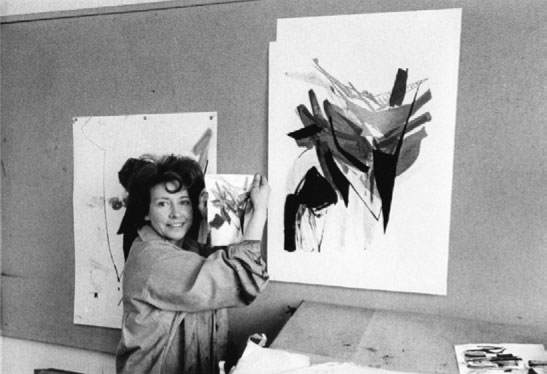
Huguette Arthur Bertrand, c. 1960
Photo: Rights reserved

Huguette Arthur Bertrand creating a monumental work in Nantes-Saint-Herblain, 1972
Photo: Rights reserved
Robert Helman (1910-1990)
Biography
ROBERT HELMAN: FROM CHILDHOOD IN ROMANIA TO STUDIES IN PARIS
Robert Helman was born on 9 February 1910 in Galati, Romania, where the Danube joins the Black Sea. Helman’s grandfather was the chief rabbi of the Kaiser in Vienna, while his father was a merchant and the owner of an alcohol distillery. His mother, meanwhile, was the president of an orphanage. She played a key role in his education, first hiring a violin teacher for her son – who showed no interest in music – and then an art teacher to give instruction in drawing and painting, lessons that would spark a real passion in the child.
Helman, who had been immersed in French culture through childhood, obtained his baccalaureate at the age of 17, at which point he expressed a desire to go to France for a university education. Quotas had been introduced in Romania at that time limiting the number of Jews that could be admitted to universities in the country. Helman’s parents accepted his decision on the condition that he studied law or medicine, which he did, enrolling at the Faculty of Law on his arrival in Paris in July 1927. The young student quickly became an activist, developing close connections with Trotskyist students such as the future writer and editor Maurice Nadeau, whose portrait Helman would later paint.
Robert Helman graduated with a law degree in 1931. During a trip back to his hometown, the young graduate met Zéna Jolles, who was also a student in Paris. Back in the French capital, they campaigned for political causes together, engaging in lengthy discussions about the Spanish war and the rise of Nazism in Germany. Zéna and Robert married in Romania in 1936, after which they returned to Paris where the latter worked for some time as a lawyer.
ROBERT HELMAN’S EXILE IN BARCELONA
In September 1939, Robert Helman volunteered for the French Army but was not enlisted because he was a Romanian citizen. Thanks to their connections with Trotskyist circles, Zéna and Robert were warned in advance of Hitler’s offensive in France and decided to leave Paris immediately to take refuge in Barcelona.
The couple were able to cross the border with the help of false baptismal certificates obtained from the parish priest of the Saint-Germain-des-Prés church in Paris. The couple found themselves destitute and had to sell their personal possessions and wedding rings. It was particularly difficult for them to find work because neither Zéna nor Robert could speak Spanish. Zéna found a job as an assistant in a hospital nonetheless, while Robert had to take on casual work waiting tables and delivering goods, among other odd jobs, despite his law degree. The couple met many refugees in Barcelona who were settling in Spain or travelling to Portugal or South America. Just as it had during the First World War, Barcelona welcomed many European artists during this period.
It was in this climate that Robert Helman began experimenting with painting. Looking for work, he entered a cobbler’s shop to make inquiries. The cobbler asked him what he liked to do, and Helman replied that he liked to paint but had no money for materials. The cobbler gave him some money and commissioned him to create a work of art. Helman painted a still life of flowers, which the cobbler immediately sold for twice the amount given to the artist. As the artist recalled, “That was the beginning of my career as a painter.”
An excellent portrait painter, Robert Helman thus began to earn a living in Barcelona through his painting. He met the painter Jaime A. Colson, a professor at the Barcelona School of Fine Arts, who taught him fresco techniques and invited him to join the artists’ collective “Los artistas de la Campana de San Gervasio”. The group, which took its name from the café where its members met, included the artists Joan Vilató and Josep Vilató (nephews of Pablo Picasso), Joan Ponç, Antoni Tápies, Modest Cuixart, José María de Sucre and the poet Joan Brossa, as well as the art critic Arnau Puig. In 1945, Helman’s work was shown for the first time in Barcelona in several galleries. The artist had his first solo exhibition in the city at the Galerias Pictoria in November.
THE PAINTER’S RETURN TO PARIS
After the Liberation of France, Zéna and Robert Helman returned to Paris, where the latter devoted himself entirely to painting. Robert moved into the former studio of a friend – the painter Emmanuel Mané-Katz, whom he had met in Barcelona –, taking up residence at 255 Boulevard Raspail in Paris’ Montparnasse district. Zéna Helman, meanwhile, joined Professor Henri Wallon’s child psychobiology team. The couple had lost many friends during the war but were reunited with the publisher Maurice Nadeau, who wrote texts for Robert’s exhibitions. The couple’s son Henri was born in 1947. That year, Robert Helman had solo exhibitions in Paris at the Galerie Berri-Raspail and in Algeria at the Galerie Alsace-Lorraine in Oran and the Galerie Le Nombre d’Or in Algiers.
The year 1948 was marked by a number of important encounters for Robert Helman, who met the Spanish painters Óscar Domínguez and Antoni Clavé as well as the Romanian painter Victor Brauner and the French-Algerian painter Jean-Michel Atlan.
This community of artists met at Le Dôme, La Coupole, Le Select, and other cafés in
the French capital, which was playing host to numerous foreign artists at the time.
That year, Robert Helman exhibited several times at the Galerie Breteau, notably
alongside Jean-Michel Atlan, Pierre Soulages, Hans Hartung, Óscar Domínguez and
Henri Goetz, among others.
In 1949, Robert Helman and Emmanuel Mané-Katz created a mural – The Tree, 1.30 x 2.10 m – for the Botanical Library in Netanya, Israel. Robert Helman then moved to Saint-Paul-de-Vence in the south of France, where he became friends with the poet André Verdet. The painter only stayed there for eight months, prevented from painting, he said, by the light of the south. Zéna and Robert Helman became naturalised French citizens on 15 July 1950. Zéna joined the French National Centre for Scientific Research as a research associate at the Hôpital Sainte-Anne in the electroencephalography department.
ROBERT HELMAN’S PIVOT AL ENCOUNTERS AS AN ARTIST
Robert Helman’s first monograph was published in 1951 by Les Gémeaux as part of a collection entitled “Les Artistes du temps présent” written by Jean Bouret. In 1952, the painter met the Italian art critic Giuseppe Marchiori who organised a solo exhibition for him at the Galleria Sandri in Venice.
Robert Helman and his son Henri travelled to Canada in 1953. Robert’s parents had moved there after the war and the artist wanted to be with his father, who was undergoing an operation at the time. In Montreal, Robert met the collectors Romeck and Lorette Shefner, who would acquire many of Robert Helman’s works over the next thirty years, creating the largest body of his work in Canada. The painter also had numerous solo exhibitions in Canada.
Robert Helman met Alexander and Stella Margulies in 1955 through his friend Emmanuel Mané-Katz. The prominent London collectors would make annual acquisitions of Robert’s work for more than fifteen years. In the same year, Robert Helman participated in the Salon de Mai and took part in group exhibitions at the Galerie Charpentier and Galerie 73 in Paris. Jean Cocteau – a friend of the artist – bought one of his works, saying: “Your canvas is a landscape where nature and the mind have intimately entwined their essential rhythms.” Robert Helman also met the gallery owner Henri Bénézit, who showed his work on many occasions.
In 1958, Robert Helman moved into the former studio of his friend, the painter Óscar Domínguez, at 83 Boulevard du Montparnasse. During the same period, he became friends with the art critic Pierre Restany, who helped to promote his work in France and Italy. In October 1959, Robert Helman’s second monograph was published by Georges Fall as part of a collection entitled “Le musée de poche” written by Philippe Soupault. The Tate Gallery in London acquired a work by Robert Helman in that same year.
In 1961, Robert Helman met the dealer Gualtieri di San Lazzaro, who would become a friend and show his work at the Galerie du XXème Siècle.
The dealer Beno d’Incelli showed Helman’s artwork many times at his Paris gallery from 1962 onwards, alongside works by Jean Dubuffet, Jean Fautrier, André Lanskoy and Serge Poliakoff. In 1963, the artist developed a relationship with Jean Bauchet, the owner of the Moulin-Rouge and several casinos. An art connoisseur, Bauchet built up the largest collection of Robert Helman’s work in France. Helman also met Harrison and Sonia Eiteljorg – American patrons of the arts whose collection would form the Indianapolis Museum of Art – who acquired many of the painter’s works. From 1964 onwards, the painter’s artworks were regularly exhibited at the Galerie Renée Laporte alongside works by artists such as Olivier Debré, Ladislas Kijno, André Marfaing and Joseph Sima.
THE ARTIST’S STUDIO IN CHAMPAGNE
In 1962, Robert Helman visited the Champagne region of France with his friend, the painter Albert Bitran, who wanted to buy a house there. Helman fell in love with the forest of Othe, which reminded him of landscapes from his childhood on the banks of the Danube. He bought a property in the region, which became his summer studio and then his main residence towards the end of his life.
In 1966, Helman met the art dealer Allan Rich who invited him to participate in the opening of his new gallery – the Stewart-Verde Gallery – in San Francisco. Robert Helman then travelled to Mexico where he discovered wood bark paper, the ideal material for an artist inspired by nature and the forest in particular. He brought a hundred leaves of bark paper back to France and used them for a series of works on trees.
Robert Helman then moved into the former studio of the painter Antoni Clavé at 45 Rue Boissonade – in the 14th arrondissement of the French capital – which he occupied until the end of his life. He left his former Paris studio at 83 Boulevard du Montparnasse to his son Henri, who was then a film student at the Louis-Lumière film school.
In 1969, the Museum of Modern Art in Tel Aviv dedicated a retrospective exhibition to Helman’s work with a catalogue containing texts by Philippe Soupault, Jacques Lassaigne, Giuseppe Marchiori, Georges Boudaille and Pierre Restany. During this stay in Israel, the artist created a series of tapestries which he exhibited in New York at the Greer Gallery in 1972. Helman created a second series of tapestries in 1973 at the Aubusson tapestry workshop.
In 1975, a third monograph devoted to Helman and written by Max-Pol Fouchet was published by Cercle d’Art. In 1981, the artist met the German gallery owner Wolfgang Gunther who gave him the opportunity to exhibit his work regularly in Germany for many years. In 1983, Robert Helman had his first major retrospective exhibition at the Orangerie de Bagatelle in Paris, organised by Françoise Marquet, curator at the Musée d’Art Moderne in Paris.
Robert Helman lost his left eye while opening a bottle of champagne at the age of 73 in 1983. Greatly impaired by the surgical procedures that followed, the artist resumed painting a few months later – once again depicting suns, a theme of his early works. In 1987, the painter received the art historian Lydia Harambourg at his studio as she was preparing
her Dictionnaire des peintres de l’École de Paris, which was published in 1993.
In 1988, Robert Helman took up permanent residence in his house in Champagne, where he created metal sculptures that were then exhibited at the Galerie Michèle Heyraud and the Galerie La Pochade in Paris. The following year, Helman signed a contract with the Galerie Eterso in Cannes, which bought some of his artworks and showed them alongside works by Olivier Debré, Hans Hartung and Gérard Schneider.
On 9 February 1990, the artist Robert Helman celebrated his 80th birthday at the Fondation Cartier pour l’Art Contemporain at the invitation of the foundation’s director Marie-Claude Beaud. Robert Helman died on 7 November 1990 at his home in Champagne, France.
COLLECTIONS (SÉLECTION)
Cagnes-sur-Mer (France), Castle Museum
Colmar (France), Unterlinden Museum
Dijon (France), Musée des Beaux-Arts – Granville Donation
Indianapolis (IN), Indianapolis Museum of Art
Jerusalem (Israel), Israel Museum
London (United Kingdom), Tate Modern Gallery
Paris (France), Fonds National d’Art Contemporain
Paris (France), Musée d’Art Moderne de Paris
Paris (France), Musée National d’Art Moderne – Centre Pompidou
Saint-Paul-de-Vence (France), Municipal Museum
Sens (France), Sens Museums
Stuttgart (Germany), Stadtmuseum
Tel Aviv (Israel), Tel Aviv Museum of Art
Troyes (France), Musée d’Art Moderne
Turin (Italy), Galleria Civica d’Arte Moderna e Contemporanea
SELECTED EXHIBITIONS
Group exhibition: Bayon, Rutta Block de Rosenstingl, Calderon, E. Castells, J. Colson, M. Fargas, Fret, Gabino, Grandara, Helman, Hubert Vallmitjana, J.O. Jansana, T. Kurimoto, Olive Busquets, Sanjuan, José M. de Sucre, Galerias Reig, Barcelona, 1945
Solo exhibition, Galerias Pictoria, Barcelona, 1945
Solo exhibition, Galerie Berri-Raspail, Paris, 1947
Solo exhibition, Galerie Alsace-Lorraine, Oran (Algeria), 1947
Solo exhibition, Galerie Le Nombre d’Or, Alger (Algeria), 1947
Solo exhibition, Galerie Breteau, Paris, 1948
Group exhibition: Les Six Jours [The Six Days], Atlan, Booumeester, Smadja, Soulages, Bertholle,
Beyer, Le Moal, Manessier, Bott, Domínguez, Hartung, Picasso, Guita, Goetz, Loubchansky, Shoffer, Helman, Moisset, Parra, Vanier, Jacobsen, Gilioli, Leleu, Étienne-Martin, Galerie Breteau, Paris, 1948
Solo exhibition, Galerie Colline, Oran (Algeria), 1948
Solo exhibition, Galerie Louis Manteau, Brussels, 1949
Solo exhibition of watercolours, Galerie Mouradian-Valloton, Paris, 1952
Solo exhibition, Incontro con Robert Helman, Galleria Sandri, Venice, 1952
Solo exhibition, Agnès Lefort Gallery, Montreal, 1954
Solo exhibition, Elisabeth Nelson Gallery, Chicago, 1954
11th Salon de Mai, Paris, 1955
Group exhibition, L’École de Paris [The Paris School], Galerie Charpentier, Paris, 1955
Group exhibition: Aïzpiri, Beaulieu, Calmettes, Clavé, Condoy, Cortot, Domínguez Nita Flores, Helman, Galerie 73, Paris, 1955
Solo exhibition, Galerie Octobon, Saint-Paul-de-Vence, 1955
Solo exhibition, Galerie Henri Bénézit, Paris, 1955, 1957
Group exhibition: Atlan, Chapoval, Garbell, Janson, Helman, Lanskoy, Pichette, Tal Coat, Galerie Henri Bénézit, Paris, 1956-1957
Group exhibition: Henri Bénézit et Éraste Touraou présentent : [Henri Bénézit and Éraste Touraou present:] Atlan, Chapoval, Helman, Lanskoy, Pichette, Tal Coat, Galerie Ex-Libris, Brussels, 1957
Group exhibition: Anthoons, Chapoval, Chavignier, Corneille, Doucet, Garbell, Guitet, Helman,
Pichette, Sugaï, Galerie Muratore, Nice, 1957
Group exhibition: Atlan, Chapoval, Garbell, Janson, Pichette, Caillaud, Duault, Helman, Lanskoy,
Tal Coat, André Verdet, Galerie Sous-Barri, Saint-Paul-de-Vence, 1957
Group exhibition, Contemporary Jewish Artists of France, Atlan, Chagall, Mané-Katz, Michonze, Zack, Helman, Ben Uri Art Gallery, London, 1957
Solo exhibition, Galleria Apollinaire, Milan, 1958
Solo exhibition, Galleria Blu, Milan, 1958
14th Salon de Mai, Paris, 1958
Solo exhibition, Nicole Gallery, New York, 1958
Solo exhibition of ink works, gouaches and drawings, La Hune, bookshop-gallery, Paris, 1959
Group exhibition, L’École de Paris : cinq critiques désignent sept artistes [The School of Paris: five critics nominate seven artists], Buffet, Pignon, Masson, Istrati, Helman, Galerie Charpentier, Paris, 1959
Group exhibition, French Painting Today, Hartung, Helman, Vieira da Silva, and others, Association of Israel Museums, Bezalel National Museum, Jerusalem, 1960
Group exhibition, Sept peintres de l’École de Paris [Seven painters of the School of Paris] (Adamoff, Helman, Abidine, Arbas, Lan-Bar, Orazi, Klieman), Galerie Pego’s, Montreal, 1960
Solo exhibition, Nicole Gallery, New York, 1960
Touring exhibition across the United Kingdom (the Towner Art Gallery, Eastbourne; the Art Gallery, Southampton; the National Museum of Wales, Cardiff; the Art Gallery, Aberdeen; the Kelvingrove Art Gallery and Museum, Glasgow; the Ferens Art Gallery, Kingston-upon-Hull; the City Museum & Art Gallery, Birmingham; the Walker Art Gallery, Liverpool) organised by the Arts Council, The Margulies Collection: New Paintings From Paris, 1960-1961
Group exhibition: Bellegarde, Halpern, Helman, Krajcberg, Orazi, Cave-Galerie Jeanne Fillon, Paris, 1961
Solo exhibition, Galerie du XXe siècle, Paris, 1961
Solo exhibition, La Forêt [The Forest], Galleria Blu, Milan, 1961
Solo exhibition, Galerie Jacques Martin, Saint-Paul-de-Vence, 1961
Solo exhibition, Galerie Parti-Pris, Grenoble, 1961
Group exhibition, Exposition des artistes de la galerie [Exhibition of the gallery’s artists]: Atlan, Dubuffet, Fautrier, Helman, Lanskoy, Maryan, Messagier, Poliakoff, Rebeyrolle, Riopelle, Tal Coat, Wols, Galerie Beno d’Incelli, Paris, 1962
Group exhibition, La Collezione di un Bambino, Galleria Il Traghetto, Venice, 1962
18th Salon de Mai, Paris, 1962
Solo exhibition, La Forêt [The Forest], Galleria il Canale, Venice, 1962
Solo exhibition, Galleria Il Centro, Naples, 1963
19th Salon de Mai, Paris, 1963
Solo exhibition, Robert Helman, Jardins et Forets [Robert Helman, Gardens and Forests], Casino Du Liban, Beirut, 1963
Solo exhibition, La Forêt [The Forest], Galerie Cavalero, Cannes, 1963
Solo exhibition, Hilt Gallery, Basel, 1963
Group exhibition, Painting and Sculpture Today, Indianapolis Museum of Art, Indianapolis, 1964
Solo exhibition, Galerie Lutz & Meyer, Stuttgart, 1964
Group exhibition, Caillaud, Chavignier, Clavé, Dumitresco, Helman, Istrati, Galerie Beno d’Incelli, Paris, 1964
Solo exhibition, La Sala Gaspar, Barcelona, 1964
Solo exhibitions, Galerie Beno d’Incelli, Paris, 1965, 1968, 1972
Solo exhibition, Stewart-Verde Gallery, San Francisco, 1966
Solo exhibition, Municipal Museum, Saint-Paul-de-Vence, 1967
Group exhibition, Robert Helman and Marcello Avenalli, Galleria Santa Maria, Rome, 1967
Solo exhibition, L’Entracte, Lausanne (Switzerland), 1969
Solo exhibition, Tel Aviv Museum of Art, Tel Aviv, 1969
Group Exhibition, Présence européenne, Galleria La Bussola, Turin, 1971
Group exhibition, Paintings and tapestries by Robert Helman; sculpture in marble by Nardo Dunchi, Allan Rich Gallery, New York et Greer Gallery, New York, 1972
Solo exhibition, Galleria Procolo, Castellana Grotte (Italy), 1972
Solo exhibition, Peintures et tapisseries sur le thème de la forêt : 1957-1972 [Paintings and tapestries on the theme of the forest: 1957-1972], Castle Museum, Cagnes-sur-Mer, 1973
Solo exhibition, Galleria La Seggiola, Salerno (Italy), 1973
Solo exhibition, Robert Helman : Peintures et Gouaches [Robert Helman: Paintings and Gouaches], Galerie Albert Verbeke, Paris, 1974
Solo exhibition, Robert Helman : Tapisseries et Écorces [Robert Helman: Tapestries and Bark Paper Works], Galerie Jacques Verrière, Paris, 1974
Solo exhibition, Kar Gallery, Toronto, 1974
Solo exhibition, Galleria Interarte, Genoa, 1974
Solo exhibition, Musée de l’Outil, Troyes, 1975
Solo exhibition, Galerie Albert Verbeke, Paris, 1975
Solo exhibition, Galerie Frédéric Gollong, Saint-Paul-de-Vence, 1975
Solo exhibition of engravings and gouaches, Artcurial, Paris, 1977
Group exhibition, Meubles Tableaux, Centre National d’Art Contemporain, Centre Pompidou, Paris, 1977
Solo exhibition, Gordon Gallery, Tel Aviv, 1977
Solo exhibition, Galleria Guglielmo Tell, Chiasso (Switzerland), 1977
Group exhibition, Le paysage intérieur, aujourd’hui, Château de Vesvres, 1978
Group exhibition, Jewish Art: paintings and sculptures by 20th-century Jewish artists from the French and British schools (Atlan, Zadkine, Soutine, Modigliani, Chagall, Helman), Kelvingrove Art Gallery and Museum, Glasgow, 1979
Solo exhibition, Figure humaine – peintures et écorces [Human Figure – paintings and bark paper works], Galerie Bellint, Paris, 1979
Solo exhibition, Château de Mont-Saint-Jean, 1980
Solo exhibition, Genèses, Galerias Rayuela, Madrid, 1981
Solo exhibition, Limmer Gallery, Freiburg (Germany), 1981, 1984, 1985, 1987, 1989
Solo exhibition, Quatre Éléments, Siete Siete Gallery, Caracas, 1981
Solo exhibition, Greer Gallery, New York, 1981
Solo exhibition, Becher Gallery, Wuppertal (Germany), 1982, 1985
Retrospective solo exhibition, Helman – Peintures 1943-1983, Orangerie de Bagatelle, Paris, 1983
Solo exhibition, Galerie Michèle Heyraud – Nadine Bresson, Paris, 1983, 1988
Group exhibition, Matisse, Picasso, Chagall, Fautrier, Bellmer, Dali, Karskaya, Fini, Helman, Scherer Gallery, Freiburg (Germany), 1983
Group exhibition, Charles Estienne & l’Art à Paris 1945-1966, Centre National des Arts Plastiques, Paris, 1984
Group exhibition, Aspect de l’art en France de 1950 à 1980, collection of Christie and Lionel Cavalero, Musée Ingres, Montauban, 1985
Solo exhibition, Robert Helman, Landscapes of Genesis, Mayanot Gallery, Jerusalem, 1986
Solo exhibition, Galerie La Pochade, Paris, 1986, 1987, 1988
Group exhibition, Accrochage 50, Galerie Nickel-Odéon, Paris, 1986
Solo exhibition, La Genèse de la Lumière [The Genesis of Light], Palais des Congrès, Megève, 1988
Group exhibition, D’hier à aujourd’hui : Arnal, Doucet, Debré, Hartung, Helman, Schneider, Galerie Eterso, Cannes, 1989
Solo exhibition, Helman – 50 ans de peinture, Galerie Eterso, Cannes, 1990
Solo exhibition, Hommage à Robert Helman, Galerie Duras-Martine Queval, Paris; Galerie Valsyra, Lausanne, Montreux; Galerie Eterso, Cannes, 1991
Retrospective solo exhibition, Helman 1910-1990, peintures et sculptures, Musée d’Art Moderne, Troyes, 1994
Solo exhibition, Galerie Nicolas Deman, Paris, 2000
Solo exhibition, Robert Helman – Paysages imaginaires de la Genèse [Robert Helman – Imaginary Landscapes of Genesis], Musée d’Unterlinden, Colmar (France), 2007
Solo exhibition, Galerie 53, Paris, 2007
Solo exhibition, Robert Helman, Orangerie, Sens Museums, Sens, 2010
Solo exhibition, Galerie 53, Paris, 2010
Group exhibition, Dmitrienko, Helman, Lindström, Maria Manton, Vieira da Silva and others, Art Elysées, Paris, 2010
Group exhibition, Gris … Ouverture sur la couleur, Asse, Bitran, Helman, Lindström, Arpad Szenes, Vieira da Silva, and others, Galerie 53, Paris, 2010
Group exhibition, La lettre secrète, Helman, Karskaya, Vieira da Silva, Jan Voss, and others, Galerie de Beaune, Paris, 2015
Group exhibition, Orient Express…de Paris à Istanbul, Abidine, Dumitresco, Hantai, Helman, Herold, Vasarely, Galerie Courtaigne, Paris 2018
BIBLIOGRAPHIE (SÉLECTION)
Jean Bouret, Helman, Paris, Les Gémeaux, “Les artistes du temps présent” collection, 1951
Jean Cassou, Les Peintres témoins de leur temps [Painters as Witnesses of their Time], Paris, Musée d’Art Moderne, 1953
Raymond Cogniat, L’Histoire de la peinture [The History of Painting], Paris, Fernand Nathan, 1955
Raymond Nacenta, École de Paris, son histoire, son époque [The School of Paris, its history, its era], Neuchâtel, Ides et Calendes, 1958
Pierre Restany, Lyrisme et Abstraction [Lyricism and Abstraction], Milan, Apollinaire, 1958
Philippe Soupault, Helman, Paris, Georges Fall, “Le Musée de Poche” collection, 1959
André Verdet, Forêts de Helman [Helman’s Forests], Saint-Paul-de-Vence, Parler, 1961
Georges Boudaille, Denys Chevalier, Marie-Henriette Foix, Alain Gheerbrant, Giuseppe Marchiori, “Helman”, Parler journal, Paris, no. 15, spring 1963
Giuseppe Marchiori, Helman, Paris, Impriludes-Bernard Lucas, Paris, 1965
André Verdet, Vers une République du Soleil [Towards a Republic of the Sun], Paris, Jean Oswald, 1968
Max-Pol Fouchet, Helman, Paris, Cercle d’Art, 1975
Ronald Alley, Catalogue of the Tate Gallery’s Collection of Modern Art Other Than Works by British Artists, London, Tate Gallery and Sotheby Parke-Bernet, 1981
Françoise Armengaud, Titres, interview with Robert Helman, 24 March 1986, Paris, Méridiens Klincksieck, 1988
Lydia Harambourg, L’École de Paris, 1945-1965, Dictionnaire des peintres [The School of Paris, 1945-1965, Dictionary of painters], Neuchâtel, Ides et Calendes, 1993
Emmanuel Bénézit, Dictionnaire des peintres, sculpteurs, dessinateurs et graveurs [Dictionary of Painters, Sculptors, Drawers and Engravers], Paris, Gründ, 2006
Lydia Harambourg, Robert Helman, Musée Unterlinden, Somogy, Paris, 2007
Lydia Harambourg, Helman, Cercle d’Art, “Découvrons l’art du XXème siècle” collection, Paris,
2010

Robert Helman in his studio, 83 boulevard du Montparnasse, Paris, 1959
Photo: Jean Louvel

Robert Helman in his studio, 83 boulevard du Montparnasse, Paris, 1963
Photo: Henri Tullio

Robert Helman’s studio, Bérulle, 2022

Huguette Arthur Bertrand in her studio, 1972
LE PAYSAGE IMAGINAIRE
Hugette Arthur Bertrand – Robert Helman
EXPOSITION: 6 décembre 2022 – 8 janvier 2023
Galerie Diane de Polignac
2 bis, rue de Gribeauval – 75007 Paris
www.dianedepolignac.com
Textes – texts: Mathilde Gubanski
Traduction – translation: Lucy Johnston
© Œuvres : ADAGP, Paris, 2022
Photographies des oeuvres : Droits réservés
© Artworks: ADAGP, Paris, 2022
Photographs of the works: Reserved rights
© Galerie Diane de Polignac, 2022
